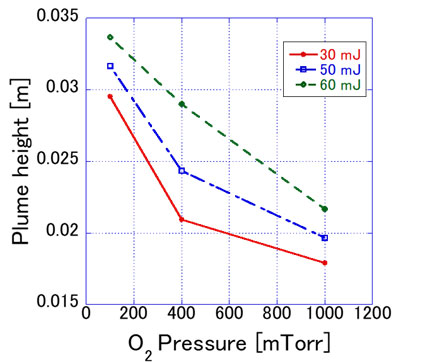WB4-9
Geometry measurement of an ablation plasma in the pulsed laser deposition method and effective investigation for using Bayesian optimization
Nov. 30 12:30-12:45
*Tomoki Osada1, Yusuke Ichino2, Yutaka Yoshida1
Nagoya University, Japan1
Aichi Institute of Technology, Japan2
Introduction
The fabrication of REBa2Cu3Oy (REBCO) superconducting thin films by the pulsed laser deposition (PLD) involves many non-quantifiable parameters such as equipment degradation, dirt, and plume shape, in addition to quantifiable parameters such as temperature and pressure. These non-quantifiable parameters also affect the thin film quality and reduce the reproducibility of the superconducting thin films.
The PLD method is a deposition technique in which the target surface is irradiated with a powerful UV pulsed laser to ablate the constituent materials. The ablated materials are then deposited on an opposing substrate. During irradiation of the target, the excited materials form a luminescent column made of plasma called a plume. The geometry of this plume varies depending on quantitative parameters such as ambient oxygen pressure and laser irradiation energy density [1]. In addition, the plume is also affected by various non-quantitative factors such as individual differences in the optics and laser source of each device, dirt on the laser input window, degradation of the laser pumping medium, and surface condition of the target. Therefore, the plume is a parameter that includes the effects of both quantitative and non-quantitative parameters.
To find the optimum fabrication conditions for superconducting thin films, such as temperature and pressure, many samples are prepared by varying these parameters, and the optimum fabrication conditions are searched by evaluating the superconducting properties for each parameter. Currently, the search for optimum fabrication conditions is based on ex-situ evaluations which are X-ray diffraction, superconducting properties and so on, but this process is not efficient. Therefore, a method based on Bayesian optimization [2] is expected to be an efficient method to search for optimal fabrication conditions.
In this study, we are developing a technique to improve the reproducibility of superconducting thin films fabrication in the PLD method by optimizing the in-situ fabrication conditions through obtainment geometric information of the plume including non-quantitative parameters. We are also developing a Bayesian optimization method using the acquired plume information to improve the efficiency of the investigation for the superconducting thin films.
In this presentation, we report on the development of the plume geometry acquisition method and the Bayesian optimization for properties of YBCO films using the plume information.
Experimental method
YBa2Cu3Oy thin films were fabricated by PLD method. The substrate temperature was 840°C, the distance between the target and the substrate was 60 mm, the energy (EL) of the KrF excimer laser (wavelength: 248 nm, repetition rate: 10 Hz, spot size: 1.7×1.2 mm2) was 30, 50, and 60 mJ, and the oxygen partial pressure (PO2) in the deposition chamber was changed to 100, 400, and 1000 mTorr. Plume images were taken using a depth camera (Intel, Realsense Depth Camera D405) during the fabrication of the nine conditions of the YBCO thin films, plume geometry (height and width) was obtained using the depth camera.
Experimental results and discussion
Figure 1 shows the plume height for different oxygen partial pressures and laser energies. The plume height varied from 0.018 m at EL =30 mJ and PO2 = 1000 mTorr to 0.034 m at EL = 60 mJ and PO2 = 100 mTorr.
From this figure, it can be confirmed that the plume height becomes lower as the oxygen partial pressure increases and the laser energy decreased. From this result, we confirmed that the depth camera could obtain the geometry of the plums because a distance between the camera and the plume can be measured, making it possible to obtain geometric information of the plume independent of a deposition equipment.
Bayesian optimization using the acquired plume information will also be presented.
References
[1] M. Hiramatsu and S. Ishibashi, The Review of Laser Engineering,18,355(1990)
[2] I. Ohkubo, Z. Hou, J.N. Lee et al, Mater. Today Phys. 16, 100296(2021)
Acknowledgements
This work was partly supported by JSPS-KAKENHI (20H02682, 21H01872) and NEDO.
Figure
Fig. Plume height of YBCO thin film fabricated by PLD method at different O2 pressures and laser energies.
Keywords: plume, Pulsed Laser Deposition, REBa2Cu3Oy
